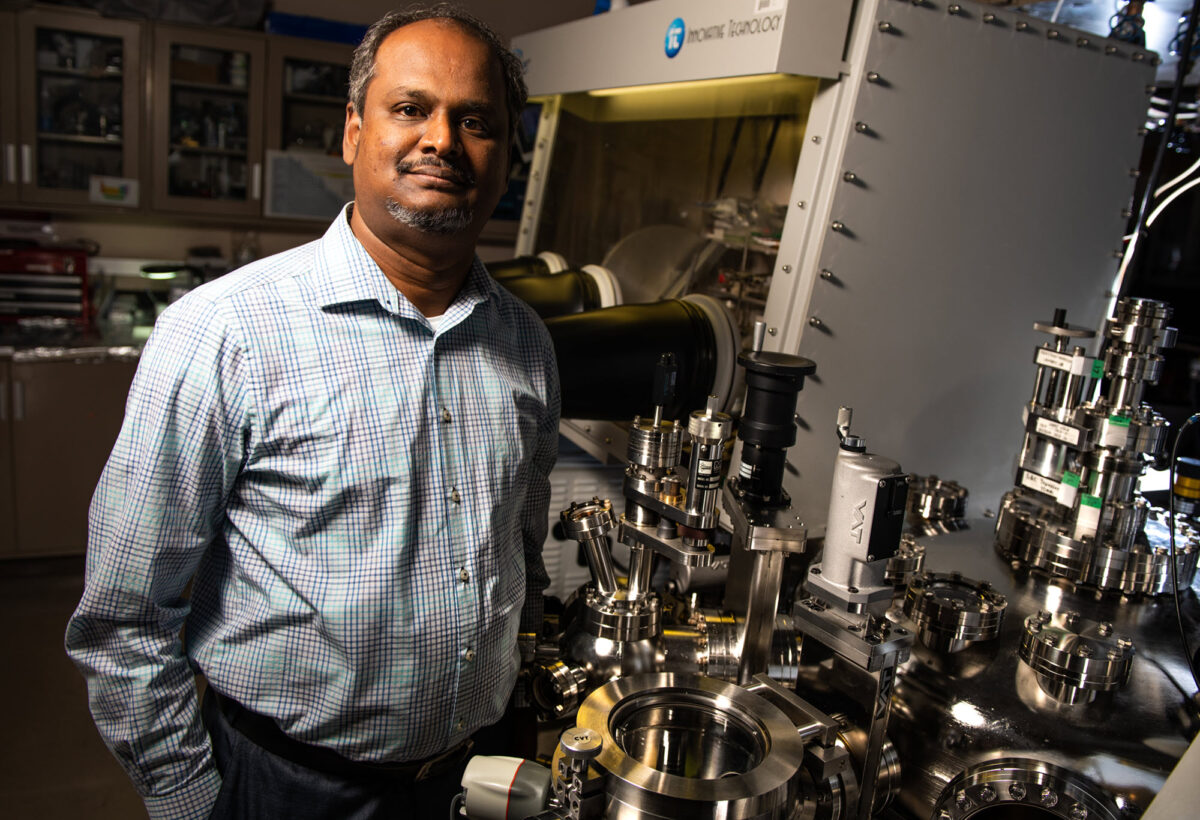 Materials scientist Vijay Murugesan and his team are studying new battery electrolyte materials identified through a collaboration with Microsoft. (Photo by Andrea Starr | Pacific Northwest National Laboratory)
Materials scientist Vijay Murugesan and his team are studying new battery electrolyte materials identified through a collaboration with Microsoft. (Photo by Andrea Starr | Pacific Northwest National Laboratory)The Department of Energy’s Pacific Northwest National Laboratory (PNNL) has teamed with Microsoft to use high-performance computing in the cloud and artificial intelligence to accelerate scientific discovery, with an initial focus on chemistry and materials science for battery solutions.
The two organizations say they are focused on leveraging what AI does best — synthesizing billions of information bits and quickly presenting conclusions based on its analysis. Microsoft’s Azure Quantum Elements platform uses AI models purpose-built to aid scientific discovery. PNNL researchers are now testing its ability to identify new materials for energy applications.
“The intersection of AI, cloud and high-performance computing, along with human scientists, we believe is key to accelerating the path to meaningful scientific results,” said PNNL’s Deputy Director for Science and Technology Tony Peurrung. “Our collaboration with Microsoft is about making AI accessible to scientists. We see the potential for AI to surface a material or an approach that is unexpected or unconventional, yet worth investigating. This is a first step in what promises to be an interesting journey to accelerate the pace of scientific discovery.”
The newly executed agreement between the two organizations formalizes the next phase of PNNL’s ongoing relationship with Microsoft. The partnership will have an initial emphasis on computational chemistry and material science.
“We are at the dawn of a new era of scientific discovery that can transform our world for the better,” said Jason Zander, Executive Vice President of Strategic Missions and Technologies at Microsoft. “With novel AI and hyperscale capabilities, we can speed up research and unlock the discovery of new molecules that can address some of the most pressing issues of our time, from clean energy to eliminating toxic chemicals and beyond. We are honored to work with world-class scientific institutions like PNNL. Our breakthrough in using AQE to find new battery materials is just one of the many examples of how our innovative approach to materials research can improve our daily lives.”
In PNNL’s Energy Sciences Center, materials scientists Vijay Murugesan, Shannon Lee, Dan Thien Nguyen, and Ajay Karakoti synthesized and tested a new compound. The entire process, from receiving the simulated candidates to producing a functioning battery, took less than nine months, PNNL said. To make the compound competitive with published benchmarks, the team says additional optimization is required and initial investigations suggest new pathways to further explore the functional properties of the new material.
“The new battery results are just one example—a proof point if you will,” said PNNL’s Chief Digital Officer Brian Abrahamson. “We recognized early on that the magic here is in the speed of AI assisting in the identification of promising materials, and our ability to immediately put those ideas into action in the laboratory. We are excited to take this to the next level in the partnership between Microsoft and PNNL. We plan to push the boundaries of what’s possible through the fusion of cutting-edge technology and scientific expertise.”
Late in 2023, PNNL created the Center for AI @PNNL to coordinate the research of hundreds of scientists working on a range of projects focused on science, security, and energy resilience.
Researchers at PNNL were among the first to dive into artificial intelligence decades ago, the laboratory said. But AI has surged in the past year with the ready availability of generative AI, which allows almost anyone to produce —though sometimes errant— text and images with just a small amount of data. At the same time, AI is a tool for serious researchers as well as a subject all its own for scientists to create, explore, and validate new ideas, PNNL said.
A priority of the Center for AI at PNNL is developing ways to keep AI secure and trustworthy, PNNL said. PNNL scientists have contributed to the IEEE Ethics Certification Program for Autonomous and Intelligent Systems, a program to make sure algorithms are trustworthy and free of bias.
Among the other areas of interest to the participants of the Center for AI at PNNL are the creation and development of an AI-ready workforce; the deployment of AI in daily operations at PNNL; exploration of how humans and AI programs can best work together; and autonomous experimentation, where AI can direct robots’ activity in the laboratory, analyze results, then map out and even direct subsequent tasks.
The laboratory also recently said in a published paper that in some parts of the country, “energy droughts” can last nearly a week, but battery storage can help alleviate some of the pressure.
When renewable energy generation halts- when the sun isn’t shining and the wind isn’t blowing- it is referred to as a “compound energy drought.” The paper, Standardized benchmark of historical compound wind and solar energy droughts across the Continental United States warns that these occurrences could have a heavy impact on an unprepared grid.
Grid operators need to know when energy droughts will occur so they can prepare to pull energy from different sources, the authors recommend. Understanding where, when, and for how long energy droughts occur can help inform grid-level battery planning so enough electricity is stored to mitigate the loss.
Researchers have studied compound droughts in the past, PNNL notes, but only on the state and regional scale. PNNL’s researchers used weather data and historical energy demand data to understand how often an energy drought occurs when that energy is needed the most.